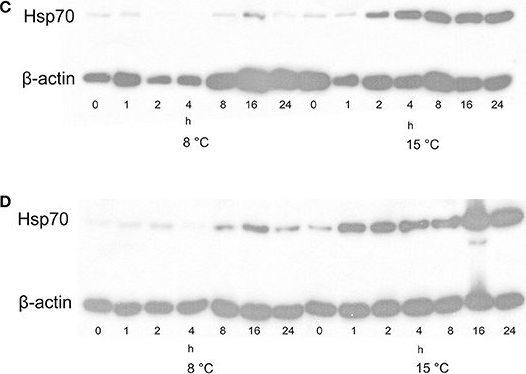Anti-HSP70 | Salmonid heat shock protein 70, Affinity purified
AS05 061A | Clonality: Polyclonal | Host: Rabbit | Reactivity: Salmon
- Product Info
-
Immunogen: KLH-conjugated synthetic peptide chosen from the C-terminal of salmonid hsp70. The target peptide is a sequence specific to salmonid hsp70 UniProt: B5X4Z3.
Host: Rabbit Clonality: Polyclonal Purity: Immunogen affinity purified serum in PBS pH 7.4. Format: Lyophilized Quantity: 200 µg Reconstitution: For reconstitution add 200 µl of sterile water Storage: Store lyophilized/reconstituted at -20°C; once reconstituted make aliquots to avoid repeated freeze-thaw cycles. Please remember to spin the tubes briefly prior to opening them to avoid any losses that might occur from material adhering to the cap or sides of the tube. Tested applications: Immunohistochemistry (IHC), Immunoprecipitation (IP), Western blot (WB) Recommended dilution: 5 µg of antibodies in reaction mixture (IP), 1 : 100 (IHC), 1 : 15 000 (WB) Expected | apparent MW: 70 kDa
- Reactivity
-
Confirmed reactivity: Oncorhynchus mykiss (Rainbow trout), Danio rerio (Zebrafish) Predicted reactivity: Coregonus clupeaformis, Oncorhynchus mykiss, Salmo salar (Atlantic salmon), Salvelinus fontinalis (Brook trout)
Not reactive in: Gasterosteus aculeatus - Application Examples
-
Application examples: 
Reactant: Salmonid fish
Application: Western Blotting
Pudmed ID: 27872596
Journal: Front Physiol
Figure Number: 5C,D
Published Date: 2016-11-23
First Author: Lewis, M., Götting, M., et al.
Impact Factor: 4.141
Open PublicationTime course of heat shock induced hsp70 mRNA and protein synthesis in Arctic charr. Relative quantities (mean ± SEM; n = 7) in (A) gills and (B) liver. Relative quantities of hsp70 are based on hsp/?-actin ratios in the western blots. Representative examples of western blots for gills are given in (C) and liver in (D). Whenever ANOVA or Kruskal-Wallis on ranks [parametric (p) or non-parametric (n-p), respectively] indicated statistically significant differences post-hoc testing (Dunnett's method) was conducted. A letter above a symbol indicates that the levels at that time point are significantly different from levels before the heat shock (p < 0.05).
- Additional Information
-
Additional information: Immunohistochemistry experiments have been done on salmon tissue treated with hydrated autoclaving of formalin fixed sections (unpublished results)
Additional information (application): This antibody is recognizing the inducible Hsp70 in salmon but not the constitutive - Background
-
Background: Heat-shock protein 70 (Hsp70) is the major stress-inducible protein in vertebrates and highly conserved throughout evolution. It plays a role as a molecular chaperone and is important for allowing cells to cope with acute stressor insult, especially those affecting the protein machinery.
- Product Citations
-
Selected references: Mottola et al. (2020). Comp Biochem Physiol A Mol Integr Physiol. 2020 Feb;240:110629. doi: 10.1016/j.cbpa.2019.110629.
Gallant el al. (2017). Physiological responses to a short-term, environmentally realistic, acute heat stress in Atlantic salmon, Salmo salar. FACETS.
Lewis et al. (2016). Different Relationship between hsp70 mRNA and hsp70 Levels in the Heat Shock Response of Two Salmonids with Dissimilar Temperature Preference. Front Physiol. 2016 Nov 7;7:511. eCollection 2016.
Curie et al. (2008). β‐Adrenergic Stimulation Enhances the Heat‐Shock Response in Fish. Physiol & Bioch. Zoology 4:414-425. - Protocols
- Antibody protocols
- Reviews:
-
This product doesn't have any reviews.



